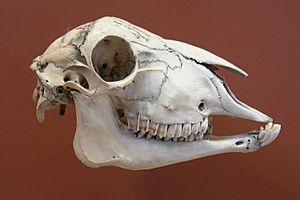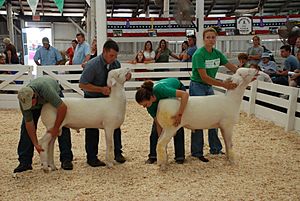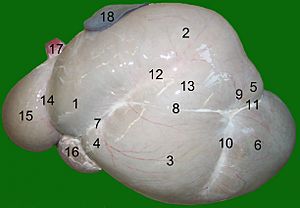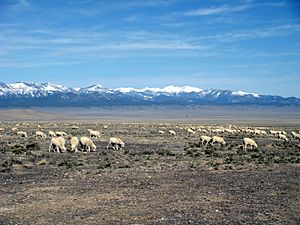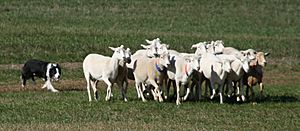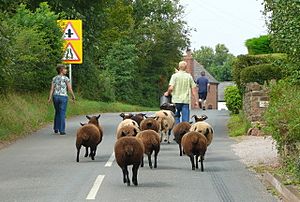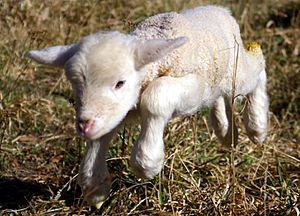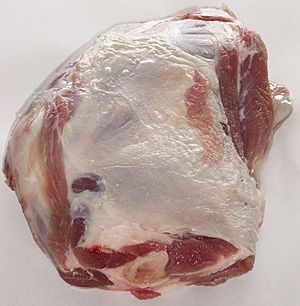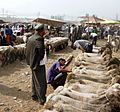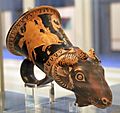Domestic sheep facts for kids
Quick facts for kids Domestic sheep |
|
|---|---|
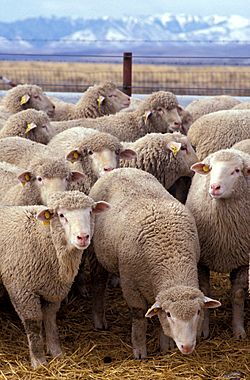 |
|
| A research flock at US Sheep Experiment Station near Dubois, Idaho | |
| Conservation status | |
| Scientific classification | |
| Kingdom: | |
| Phylum: | |
| Class: | |
| Order: | |
| Family: | |
| Subfamily: | |
| Genus: | |
| Species: |
O. aries
|
| Binomial name | |
| Ovis aries Linnaeus, 1758
|
|
A domestic sheep (Ovis aries) is a domesticated mammal related to wild sheep and goats. Female sheep are called ewes. Male sheep are called rams. Young sheep are called lambs.
They are kept for their wool and their meat. The wool of sheep, after cleaning and treating, is used to make woollen clothes. The meat of young sheep is called lamb, and the meat from adult sheep is called mutton. Both are economically important products which have been used since prehistoric times.
Sheep are domesticated animals which have been bred by man. There are breeds which specialise in wool or meat.
The plural of "sheep" is just "sheep".
Contents
Characteristics
Domestic sheep are relatively small ruminants, usually with a crimped hair called wool and often with horns forming a lateral spiral. Domestic sheep differ from their wild relatives and ancestors in several respects, having become uniquely neotenic as a result of selective breeding by humans. A few primitive breeds of sheep retain some of the characteristics of their wild cousins, such as short tails. Depending on breed, domestic sheep may have no horns at all (i.e. polled), or horns in both sexes, or in males only. Most horned breeds have a single pair, but a few breeds may have several.
Another trait unique to domestic sheep as compared to wild ovines is their wide variation in color. Wild sheep are largely variations of brown hues, and variation within species is extremely limited. Colors of domestic sheep range from pure white to dark chocolate brown, and even spotted or piebald. Selection for easily dyeable white fleeces began early in sheep domestication, and as white wool is a dominant trait it spread quickly. However, colored sheep do appear in many modern breeds, and may even appear as a recessive trait in white flocks. While white wool is desirable for large commercial markets, there is a niche market for colored fleeces, mostly for handspinning. The nature of the fleece varies widely among the breeds, from dense and highly crimped, to long and hairlike. There is variation of wool type and quality even among members of the same flock, so wool classing is a step in the commercial processing of the fibre.
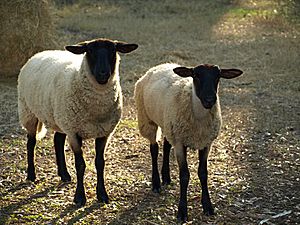
Depending on breed, sheep show a range of heights and weights. Their rate of growth and mature weight is a heritable trait that is often selected for in breeding. Ewes typically weigh between 45 and 100 kilograms (100 and 220 lb), and rams between 45 and 160 kilograms (100 and 350 lb). When all deciduous teeth have erupted, the sheep has 20 teeth. Mature sheep have 32 teeth. As with other ruminants, the front teeth in the lower jaw bite against a hard, toothless pad in the upper jaw. These are used to pick off vegetation, then the rear teeth grind it before it is swallowed. There are eight lower front teeth in ruminants, but there is some disagreement as to whether these are eight incisors, or six incisors and two incisor-shaped canines. This means that the dental formula for sheep is either 0.0.3.34.0.3.3 or 0.0.3.33.1.3.3 There is a large diastema between the incisors and the molars. In the first few years of life one can calculate the age of sheep from their front teeth, as a pair of milk teeth is replaced by larger adult teeth each year, the full set of eight adult front teeth being complete at about four years of age. The front teeth are then gradually lost as sheep age, making it harder for them to feed and hindering the health and productivity of the animal. For this reason, domestic sheep on normal pasture begin to slowly decline from four years on, and the life expectancy of a sheep is 10 to 12 years, though some sheep may live as long as 20 years.
Sheep have good hearing, and are sensitive to noise when being handled. Sheep have horizontal slit-shaped pupils, with excellent peripheral vision; with visual fields of about 270° to 320°, sheep can see behind themselves without turning their heads. Many breeds have only short hair on the face, and some have facial wool (if any) confined to the poll and or the area of the mandibular angle; the wide angles of peripheral vision apply to these breeds. A few breeds tend to have considerable wool on the face; for some individuals of these breeds, peripheral vision may be greatly reduced by "wool blindness", unless recently shorn about the face. Sheep have poor depth perception; shadows and dips in the ground may cause sheep to baulk. In general, sheep have a tendency to move out of the dark and into well-lit areas, and prefer to move uphill when disturbed. Sheep also have an excellent sense of smell, and, like all species of their genus, have scent glands just in front of the eyes, and interdigitally on the feet. The purpose of these glands is uncertain, but those on the face may be used in breeding behaviors. The foot glands might also be related to reproduction, but alternative reasons, such as secretion of a waste product or a scent marker to help lost sheep find their flock, have also been proposed.
Comparison with goats
Sheep and goats are closely related: both are in the subfamily Caprinae. However, they are separate species, so hybrids rarely occur, and are always infertile. A hybrid of a ewe and a buck (a male goat) is called a sheep-goat hybrid (only a single such animal has been confirmed), and is not to be confused with the sheep-goat chimera, though both are known as geep. Visual differences between sheep and goats include the beard of goats and divided upper lip of sheep. Sheep tails also hang down, even when short or docked, while the short tails of goats are held upwards. Also, sheep breeds are often naturally polled (either in both sexes or just in the female), while naturally polled goats are rare (though many are polled artificially). Males of the two species differ in that buck goats acquire a unique and strong odor during the rut, whereas rams do not.
Breeds
The domestic sheep is a multi-purpose animal, and the more than 200 breeds now in existence were created to serve these diverse purposes. Some sources give a count of a thousand or more breeds, but these numbers cannot be verified, according to some sources. Almost all sheep are classified as being best suited to furnishing a certain product: wool, meat, milk, hides, or a combination in a dual-purpose breed. Other features used when classifying sheep include face color (generally white or black), tail length, presence or lack of horns, and the topography for which the breed has been developed. This last point is especially stressed in the UK, where breeds are described as either upland (hill or mountain) or lowland breeds. A sheep may also be of a fat-tailed type, which is a dual-purpose sheep common in Africa and Asia with larger deposits of fat within and around its tail.
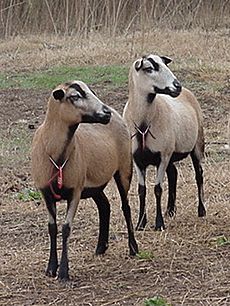
Breeds are often categorized by the type of their wool. Fine wool breeds are those that have wool of great crimp and density, which are preferred for textiles. Most of these were derived from Merino sheep, and the breed continues to dominate the world sheep industry. Downs breeds have wool between the extremes, and are typically fast-growing meat and ram breeds with dark faces. Some major medium wool breeds, such as the Corriedale, are dual-purpose crosses of long and fine-wooled breeds and were created for high-production commercial flocks. Long wool breeds are the largest of sheep, with long wool and a slow rate of growth. Long wool sheep are most valued for crossbreeding to improve the attributes of other sheep types. For example: the American Columbia breed was developed by crossing Lincoln rams (a long wool breed) with fine-wooled Rambouillet ewes.
Coarse or carpet wool sheep are those with a medium to long length wool of characteristic coarseness. Breeds traditionally used for carpet wool show great variability, but the chief requirement is a wool that will not break down under heavy use (as would that of the finer breeds). As the demand for carpet-quality wool declines, some breeders of this type of sheep are attempting to use a few of these traditional breeds for alternative purposes. Others have always been primarily meat-class sheep.
A minor class of sheep are the dairy breeds. Dual-purpose breeds that may primarily be meat or wool sheep are often used secondarily as milking animals, but there are a few breeds that are predominantly used for milking. These sheep produce a higher quantity of milk and have slightly longer lactation curves. In the quality of their milk, the fat and protein content percentages of dairy sheep vary from non-dairy breeds, but lactose content does not.
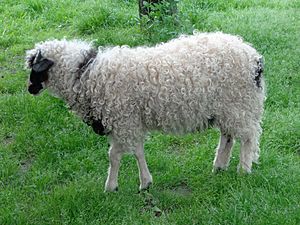
A last group of sheep breeds is that of fur or hair sheep, which do not grow wool at all. Hair sheep are similar to the early domesticated sheep kept before woolly breeds were developed, and are raised for meat and pelts. Some modern breeds of hair sheep, such as the Dorper, result from crosses between wool and hair breeds. For meat and hide producers, hair sheep are cheaper to keep, as they do not need shearing. Hair sheep are also more resistant to parasites and hot weather.
Diet
Sheep are exclusively herbivorous mammals. Most breeds prefer to graze on grass and other short roughage, avoiding the taller woody parts of plants that goats readily consume. Both sheep and goats use their lips and tongues to select parts of the plant that are easier to digest or higher in nutrition. Sheep, however, graze well in monoculture pastures where most goats fare poorly.
Like all ruminants, sheep have a complex digestive system composed of four chambers, allowing them to break down cellulose from stems, leaves, and seed hulls into simpler carbohydrates. When sheep graze, vegetation is chewed into a mass called a bolus, which is then passed into the rumen, via the reticulum. The rumen is a 19- to 38-liter (5 to 10 gal) organ in which feed is fermented. The fermenting organisms include bacteria, fungi, and protozoa. (Other important rumen organisms include some archaea, which produce methane from carbon dioxide.) The bolus is periodically regurgitated back to the mouth as cud for additional chewing and salivation. After fermentation in the rumen, feed passes into the reticulum and the omasum; special feeds such as grains may bypass the rumen altogether. After the first three chambers, food moves into the abomasum for final digestion before processing by the intestines. The abomasum is the only one of the four chambers analogous to the human stomach, and is sometimes called the "true stomach".
Other than forage, the other staple feed for sheep is hay, often during the winter months. The ability to thrive solely on pasture (even without hay) varies with breed, but all sheep can survive on this diet. Also included in some sheep's diets are minerals, either in a trace mix or in licks. Feed provided to sheep must be specially formulated, as most cattle, poultry, pig, and even some goat feeds contain levels of copper that are lethal to sheep. The same danger applies to mineral supplements such as salt licks.
Grazing behavior
Sheep follow a diurnal pattern of activity, feeding from dawn to dusk, stopping sporadically to rest and chew their cud. Ideal pasture for sheep is not lawnlike grass, but an array of grasses, legumes and forbs. Types of land where sheep are raised vary widely, from pastures that are seeded and improved intentionally to rough, native lands. Common plants toxic to sheep are present in most of the world, and include (but are not limited to) cherry, some oaks and acorns, tomato, yew, rhubarb, potato, and rhododendron.
Effects on pasture
Sheep are largely grazing herbivores, unlike browsing animals such as goats and deer that prefer taller foliage. With a much narrower face, sheep crop plants very close to the ground and can overgraze a pasture much faster than cattle. For this reason, many shepherds use managed intensive rotational grazing, where a flock is rotated through multiple pastures, giving plants time to recover. Paradoxically, sheep can both cause and solve the spread of invasive plant species. By disturbing the natural state of pasture, sheep and other livestock can pave the way for invasive plants. However, sheep also prefer to eat invasives such as cheatgrass, leafy spurge, kudzu and spotted knapweed over native species such as sagebrush, making grazing sheep effective for conservation grazing. Research conducted in Imperial County, California compared lamb grazing with herbicides for weed control in seedling alfalfa fields. Three trials demonstrated that grazing lambs were just as effective as herbicides in controlling winter weeds. Entomologists also compared grazing lambs to insecticides for insect control in winter alfalfa. In this trial, lambs provided insect control as effectively as insecticides.
Behavior
Flock behavior
Sheep are flock animals and strongly gregarious; much sheep behavior can be understood on the basis of these tendencies. The dominance hierarchy of sheep and their natural inclination to follow a leader to new pastures were the pivotal factors in sheep being one of the first domesticated livestock species. Furthermore, in contrast to the red deer and gazelle (two other ungulates of primary importance to meat production in prehistoric times), sheep do not defend territories although they do form home ranges. All sheep have a tendency to congregate close to other members of a flock, although this behavior varies with breed, and sheep can become stressed when separated from their flock members. During flocking, sheep have a strong tendency to follow and a leader may simply be the first individual to move. Relationships in flocks tend to be closest among related sheep: in mixed-breed flocks, subgroups of the same breed tend to form, and a ewe and her direct descendants often move as a unit within large flocks. Sheep can become hefted to one particular local pasture (heft) so they do not roam freely in unfenced landscapes. Lambs learn the heft from ewes and if whole flocks are culled it must be retaught to the replacement animals.
Flock behaviour in sheep is generally only exhibited in groups of four or more sheep; fewer sheep may not react as expected when alone or with few other sheep. Being a prey species, the primary defense mechanism of sheep is to flee from danger when their flight zone is entered. Cornered sheep may charge and butt, or threaten by hoof stamping and adopting an aggressive posture. This is particularly true for ewes with newborn lambs.
In regions where sheep have no natural predators, none of the native breeds of sheep exhibit a strong flocking behavior.
Herding
Farmers exploit flocking behavior to keep sheep together on unfenced pastures such as hill farming, and to move them more easily. For this purpose shepherds may use herding dogs in this effort, with a highly bred herding ability. Sheep are food-oriented, and association of humans with regular feeding often results in sheep soliciting people for food. Those who are moving sheep may exploit this behavior by leading sheep with buckets of feed.
Intelligence and learning ability
Sheep are frequently thought of as unintelligent animals. Their flocking behavior and quickness to flee and panic can make shepherding a difficult endeavor for the uninitiated. Despite these perceptions, a University of Illinois monograph on sheep reported them to be just below pigs and on par with cattle in IQ. Sheep can recognize individual human and ovine faces, and remember them for years. In addition to long-term facial recognition of individuals, sheep can also differentiate emotional states through facial characteristics. If worked with patiently, sheep may learn their names and many sheep are trained to be led by halter for showing and other purposes. Sheep have also responded well to clicker training.
It has been reported that some sheep have apparently shown problem-solving abilities; a flock in West Yorkshire, England allegedly found a way to get over cattle grids by rolling on their backs, although documentation of this has relied on anecdotal accounts.
Vocalisations
Sounds made by domestic sheep include bleats, grunts, rumbles and snorts. Bleating ("baaing") is used mostly for contact communication, especially between dam and lambs, but also at times between other flock members. The bleats of individual sheep are distinctive, enabling the ewe and her lambs to recognize each other's vocalizations. Vocal communication between lambs and their dam declines to a very low level within several weeks after parturition. A variety of bleats may be heard, depending on sheep age and circumstances. Apart from contact communication, bleating may signal distress, frustration or impatience; however, sheep are usually silent when in pain. Isolation commonly prompts bleating by sheep. Pregnant ewes may grunt when in labor. Rumbling sounds are made by the ram during courting; somewhat similar rumbling sounds may be made by the ewe, especially when with her neonate lambs. A snort (explosive exhalation through the nostrils) may signal aggression or a warning, and is often elicited from startled sheep.
Senses
Sheep become stressed when isolated; this stress is reduced if they are provided with a mirror, indicating that the sight of other sheep reduces stress.
Taste is the most important sense in sheep, establishing forage preferences, with sweet and sour plants being preferred and bitter plants being more commonly rejected. Touch and sight are also important in relation to specific plant characteristics, such as succulence and growth form.
Reproduction
Sheep follow a similar reproductive strategy to other herd animals. A group of ewes is generally mated by a single ram, who has either been chosen by a breeder or (in feral populations) has established dominance through physical contest with other rams. Most sheep are seasonal breeders, although some are able to breed year-round. Ewes generally reach sexual maturity at six to eight months old, and rams generally at four to six months. However, there are exceptions. For example, Finnsheep ewe lambs may reach puberty as early as 3 to 4 months, and Merino ewes sometimes reach puberty at 18 to 20 months. Ewes have estrus cycles about every 17 days, during which they emit a scent and indicate readiness through physical displays towards rams. A minority of rams (8% on average) display a preference for homosexuality and a small number of the females that were accompanied by a male fetus in utero are freemartins (female animals that are behaviorally masculine and lack functioning ovaries).
In feral sheep, rams may fight during the rut to determine which individuals may mate with ewes. Rams, especially unfamiliar ones, will also fight outside the breeding period to establish dominance; rams can kill one another if allowed to mix freely. During the rut, even usually friendly rams may become aggressive towards humans due to increases in their hormone levels.
After mating, sheep have a gestation period of about five months, and normal labor takes one to three hours. Although some breeds regularly throw larger litters of lambs, most produce single or twin lambs. During or soon after labor, ewes and lambs may be confined to small lambing jugs, small pens designed to aid both careful observation of ewes and to cement the bond between them and their lambs.
Ovine obstetrics can be problematic. By selectively breeding ewes that produce multiple offspring with higher birth weights for generations, sheep producers have inadvertently caused some domestic sheep to have difficulty lambing; balancing ease of lambing with high productivity is one of the dilemmas of sheep breeding. In the case of any such problems, those present at lambing may assist the ewe by extracting or repositioning lambs. After the birth, ewes ideally break the amniotic sac (if it is not broken during labor), and begin licking clean the lamb. Most lambs will begin standing within an hour of birth. In normal situations, lambs nurse after standing, receiving vital colostrum milk. Lambs that either fail to nurse or are rejected by the ewe require help to survive, such as bottle-feeding or fostering by another ewe.
After lambs are several weeks old, lamb marking (ear tagging, docking, and castrating) is carried out. Vaccinations are usually carried out at this point as well. Ear tags with numbers are attached, or ear marks are applied, for ease of later identification of sheep. Castration is performed on ram lambs not intended for breeding, although some shepherds choose to omit this for ethical, economic or practical reasons. However, many would disagree with regard to timing. Docking and castration are commonly done after 24 hours (to avoid interference with maternal bonding and consumption of colostrum) and are often done not later than one week after birth, to minimize pain, stress, recovery time and complications. The first course of vaccinations (commonly anti-clostridial) is commonly given at an age of about 10 to 12 weeks; i.e. when the concentration of maternal antibodies passively acquired via colostrum is expected to have fallen low enough to permit development of active immunity. Ewes are often revaccinated annually about 3 weeks before lambing, to provide high antibody concentrations in colostrum during the first several hours after lambing. Ram lambs that will either be slaughtered or separated from ewes before sexual maturity are not usually castrated. Tail docking is commonly done for welfare, having been shown to reduce risk of flystrike. Objections to all these procedures have been raised by animal rights groups, but farmers defend them by saying they solve many practical and veterinary problems, and inflict only temporary pain.
Predators
Other than parasites and disease, predation is a threat to sheep and the profitability of sheep raising. Sheep have little ability to defend themselves, compared with other species kept as livestock. Even if sheep survive an attack, they may die from their injuries or simply from panic. However, the impact of predation varies dramatically with region. In Africa, Australia, the Americas, and parts of Europe and Asia predators are a serious problem. In the United States, for instance, over one third of sheep deaths in 2004 were caused by predation. In contrast, other nations are virtually devoid of sheep predators, particularly islands known for extensive sheep husbandry. Worldwide, canids—including the domestic dog—are responsible for most sheep deaths. Other animals that occasionally prey on sheep include: felines, bears, birds of prey, ravens and feral hogs.
Sheep producers have used a wide variety of measures to combat predation. Pre-modern shepherds used their own presence, livestock guardian dogs, and protective structures such as barns and fencing. Fencing (both regular and electric), penning sheep at night and lambing indoors all continue to be widely used. More modern shepherds used guns, traps, and poisons to kill predators, causing significant decreases in predator populations. In the wake of the environmental and conservation movements, the use of these methods now usually falls under the purview of specially designated government agencies in most developed countries.
The 1970s saw a resurgence in the use of livestock guardian dogs and the development of new methods of predator control by sheep producers, many of them non-lethal. Donkeys and guard llamas have been used since the 1980s in sheep operations, using the same basic principle as livestock guardian dogs. Interspecific pasturing, usually with larger livestock such as cattle or horses, may help to deter predators, even if such species do not actively guard sheep. In addition to animal guardians, contemporary sheep operations may use non-lethal predator deterrents such as motion-activated lights and noisy alarms.
Economic importance
Sheep are an important part of the global agricultural economy. However, their once vital status has been largely replaced by other livestock species, especially the pig, chicken, and cow. China, Australia, India, and Iran have the largest modern flocks, and serve both local and exportation needs for wool and mutton. Other countries such as New Zealand have smaller flocks but retain a large international economic impact due to their export of sheep products. Sheep also play a major role in many local economies, which may be niche markets focused on organic or sustainable agriculture and local food customers. Especially in developing countries, such flocks may be a part of subsistence agriculture rather than a system of trade. Sheep themselves may be a medium of trade in barter economies.
Domestic sheep provide a wide array of raw materials. Wool was one of the first textiles, although in the late 20th century wool prices began to fall dramatically as the result of the popularity and cheap prices for synthetic fabrics. For many sheep owners, the cost of shearing is greater than the possible profit from the fleece, making subsisting on wool production alone practically impossible without farm subsidies. Fleeces are used as material in making alternative products such as wool insulation. In the 21st century, the sale of meat is the most profitable enterprise in the sheep industry, even though far less sheep meat is consumed than chicken, pork or beef.
Sheepskin is likewise used for making clothes, footwear, rugs, and other products. Byproducts from the slaughter of sheep are also of value: sheep tallow can be used in candle and soap making, sheep bone and cartilage has been used to furnish carved items such as dice and buttons as well as rendered glue and gelatin. Sheep intestine can be formed into sausage casings, and lamb intestine has been formed into surgical sutures, as well as strings for musical instruments and tennis rackets. Sheep droppings, which are high in cellulose, have even been sterilized and mixed with traditional pulp materials to make paper. Of all sheep byproducts, perhaps the most valuable is lanolin: the waterproof, fatty substance found naturally in sheep's wool and used as a base for innumerable cosmetics and other products.
As food
Sheep meat and milk were one of the earliest staple proteins consumed by human civilization after the transition from hunting and gathering to agriculture. Sheep meat prepared for food is known as either mutton or lamb. "Mutton" is derived from the Old French moton, which was the word for sheep used by the Anglo-Norman rulers of much of the British Isles in the Middle Ages. This became the name for sheep meat in English, while the Old English word sceap was kept for the live animal. Throughout modern history, "mutton" has been limited to the meat of mature sheep usually at least two years of age; "lamb" is used for that of immature sheep less than a year.
In the 21st century, the nations with the highest consumption of sheep meat are the Arab States of the Persian Gulf, New Zealand, Australia, Greece, Uruguay, the United Kingdom and Ireland. These countries eat 14–40 lbs (3–18 kg) of sheep meat per capita, per annum. Sheep meat is also popular in France, Africa (especially the Maghreb), the Caribbean, the rest of the Middle East, India, and parts of China. This often reflects a history of sheep production. In these countries in particular, dishes comprising alternative cuts and offal may be popular or traditional. Perhaps the most unusual dish of sheep meat is the Scottish haggis, composed of various sheep innards cooked along with oatmeal and chopped onions inside its stomach. In comparison, countries such as the U.S. consume only a pound or less (under 0.5 kg), with Americans eating 50 pounds (22 kg) of pork and 65 pounds (29 kg) of beef. In addition, such countries rarely eat mutton, and may favor the more expensive cuts of lamb: mostly lamb chops and leg of lamb.
Though sheep's milk may be drunk rarely in fresh form, today it is used predominantly in cheese and yogurt making. Sheep have only two teats, and produce a far smaller volume of milk than cows. However, as sheep's milk contains far more fat, solids, and minerals than cow's milk, it is ideal for the cheese-making process. It also resists contamination during cooling better because of its much higher calcium content. Well-known cheeses made from sheep milk include the Feta of Bulgaria and Greece, Roquefort of France, Manchego from Spain, the Pecorino Romano (the Italian word for sheep is pecore) and Ricotta of Italy. Yogurts, especially some forms of strained yogurt, may also be made from sheep milk. Many of these products are now often made with cow's milk, especially when produced outside their country of origin. Sheep milk contains 4.8% lactose, which may affect those who are intolerant.
As with other domestic animals, the meat of uncastrated males is inferior in quality, especially as they grow. A "bucky" lamb is a lamb which was not castrated early enough, or which was castrated improperly. These lambs are worth less at market.
In science
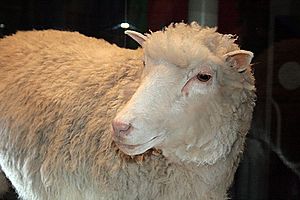
Sheep are generally too large and reproduce too slowly to make ideal research subjects, and thus are not a common model organism. They have, however, played an influential role in some fields of science. In particular, the Roslin Institute of Edinburgh, Scotland used sheep for genetics research that produced groundbreaking results. In 1995, two ewes named Megan and Morag were the first mammals cloned from differentiated cells. A year later, a Finnish Dorset sheep named Dolly, dubbed "the world's most famous sheep" in Scientific American, was the first mammal to be cloned from an adult somatic cell. Following this, Polly and Molly were the first mammals to be simultaneously cloned and transgenic.
Domestic sheep are sometimes used in medical research, particularly for researching cardiovascular physiology, in areas such as hypertension and heart failure. Pregnant sheep are also a useful model for human pregnancy, and have been used to investigate the effects on fetal development of malnutrition and hypoxia. In behavioral sciences, sheep have been used in isolated cases for the study of facial recognition, as their mental process of recognition is qualitatively similar to humans.
Images for kids
-
Suffolks are a medium wool, black-faced breed of meat sheep that make up 60% of the sheep population in the U.S.
-
A flock of Australian White hair sheep in Mudgegonga, Victoria, Australia. This is a new breed of hair sheep suited for the hot and varied Australian climate
-
Flock of sheep in South Africa (2015)
-
Shorn sheep for sale, Kashgar Market
-
Ancient Greek red-figure ram-head rhyton, ca. 340 BC
-
Jesus is depicted as "The Good Shepherd", with the sheep being Christians
See also
 In Spanish: Oveja para niños
In Spanish: Oveja para niños


